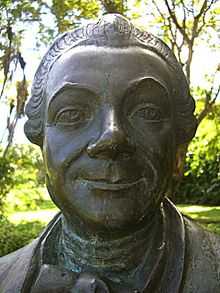Pierre Poivre

Pierre Poivre (23 August 1719 – 6 January 1786) was a French horticulturist born in Lyon; he was a missionary to China and Cochinchina, Intendant of the Islands of Mauritius and Bourbon, and wearer of the cordon of St. Michel.[1] He was an uncle to renowned French naturalist Pierre Sonnerat (1748-1814).
In his early 20s he was a missionary in Far Eastern locations that included Cochinchina, Guangzhou and Macau. In 1745 as a member of the French East India Company, while on a journey to the East Indies, he was struck by a cannonball on the wrist while being engaged in a naval battle with the British. The injury required the amputation of part of his right arm.
In the 1760s, Poivre became administrator of Isle de France (now Mauritius) and Ile Bourbon (Réunion) in the Indian Ocean. On Mauritius, he is renowned for the construction of a botanical garden consisting of trees, shrubs and plants imported from tropical sites worldwide. Here he was later succeeded as director by botanist Jean-Nicolas Céré.
He is also remembered for introducing to Mauritius and Reunion, spice plants such as clove and nutmeg, commodities which at the time were controlled by the Dutch, who had a virtual monopoly on these spices in the East Indies. In order to obtain the spices, Poivre had to arrange clandestine smuggling forays in order to obtain plants and seeds from the Indies (the expeditions to obtain the species were conducted in 1769-1770).[2] Poivre was also responsible for introducing spice plants to the Seychelles.

Today on northern Mauritius, the Botanical Garden of Pamplemousses that Poivre created still flourishes, it is now a 25-hectare garden containing tropical plants and trees from Africa, Asia, the Americas, as well as islands of the Indian Ocean.
Poivre's book, The Voyages of a Philosopher, was read with interest by Thomas Jefferson; his description of mountain rice cultivated in Vietnam caught Jefferson's attention.[3]

Pierre's surname means pepper (Poivre;![]() pronunciation ) in French, leading some authors to identify him as the subject of the Peter Piper rhyme.[4][5] Poivre Atoll, located in the Amirantes Island Group, is named in his honor.
pronunciation ) in French, leading some authors to identify him as the subject of the Peter Piper rhyme.[4][5] Poivre Atoll, located in the Amirantes Island Group, is named in his honor.
Writings by Poivre
- Voyages of a Philosopher (Voyages d'un philosophe ou observations sur les moeurs et les arts des peuples de l'Afrique, de l'Asie et de l'Amérique) by Pierre Poivre, Fortuné-Barthélemy de Félice, 1769.
- Tableau historique de l'Inde, contenant un abrégé de la mithologie et des mœurs indiennes; Pierre Poivre, Aux dépens de la Société typographique, 1771
References
- ↑ Pierre Poivre: Eighteenth Century Explorer of Southeast Asia Lewis A. Maverick The Pacific Historical Review, Vol. 10, No. 2 (Jun., 1941), pp. 165-177
- ↑ The Scents of Eden: A Narrative of the Spice Trade, Charles Corn, Kodansha America, 1998 ISBN 1-56836-249-8, ISBN 978-1-56836-249-6; 223 pp.:
"Provost set out in May 1769 for the Spice Islands.. ..Poivre had been a tireless collector of intelligence on the islands, and his sources informed him of the discovery of a small, uninhabited island northwest of Ternate called Miao, where spices grew in abundance and the Dutch were not especially vigilant as to its security.."
- ↑ Rice - Thomas Jefferson Encyclopedia. A quote:
Jefferson now turned his attention from the commercial success of his southern countrymen to their health. In the summer of 1787 he began to wonder whether the culture of dry rice might "enable us to get rid of those ponds of stagnant water so fatal to human health and life." He had been reading the Voyages d'un Philosophe by Pierre Poivre, a man who had traveled the Far East as a missionary - first for the Catholic faith and then for French colonial agriculture. During an adventurous life, in which he was captured three times by the British, Poivre introduced the nutmeg, clove, and other Asian plants to the colonies of Isle de France and Bourbon (today Mauritius and Reunion). To break the Dutch monopoly of the spice trade, he too resorted to smuggling, and even to night raids. But it was Poivre's description of the mountain rice of Vietnam, a country ruled by philosopher-princes, that particularly caught Jefferson's attention.
- ↑ Hassall, S.; Hassall, P.J. (1988). "Exploration, Discovery and Settlement". Seychelles. Places and People of the World. Chelsea House. p. 26. ISBN 0-7910-0104-0.
- ↑ Lionnet, Guy (1972). "Geography, Geology and Government". The Seychelles. The Islands Series. Stackpole Books (U.S.)/David & Charles (UK). p. 28. ISBN 0-8117-1514-0.
- ↑ "Author Query for 'Poivre'". International Plant Names Index.
External links
| Wikimedia Commons has media related to Pierre Poivre. |
- Photos of the Botanical Garden of Pamplemousses
- Mauritius Heritage in Pamplemousses Gardens - article by Tony Smart, July 30, 2008
|